During a late-season heavy snowfall at Snoqualmie Pass, we returned to the Gold Creek Sno Park, this time to hike towards Kendall Peak Lakes. The season for this snowshoe hike typically extends to early March, but it was still viable mid-April with the several inches of fresh snow that had recently fallen.
We were among the first ones there, with only two sets of snowshoe prints ahead of us. Eventually we passed the other snowshoers and continued on through unbroken snow. With snow still falling, the winter scenery was fabulous. The trees were thick with snow and the weight caused frequent dumps from the tree branches.
Road conditions were poor on the way up. Several cars had slid off the road and many more had stopped to install chains. A lot more snow had fallen by the time we finished our hike, and conditions seemed much worse. We were expecting that chains might be required, but the guidance hadn’t changed from the morning’s “traction tires advised”, the lowest of the four Washington mountain pass traction requirements. We passed a multi-car accident a short distance west of the Snoqualmie Pass ski area. Several of the vehicles looked badly damaged, but no-one was obviously hurt. The accident had just happened and we felt lucky to have missed that one.
Below are highlights from April 10, 2022. Click any image for a larger view, or click the position to view the location on a map. And a map with our most recent log entries always is available at mvdirona.com/maps.
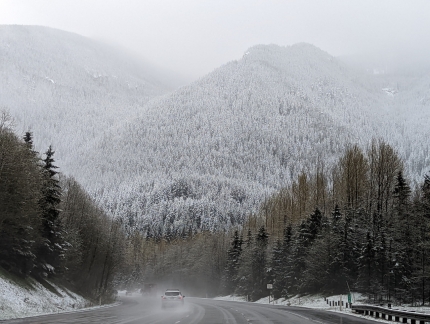 |
Rain
Position: 47°27.64’N, -121°42.27’W
Rain is falling at altitude 628 ft (192 m) on I-90 en route to Snoqualmie Pass, with a fresh dusting visible from overnight. As we climb towards the pass, the rain should switch to a late-season snow.
|
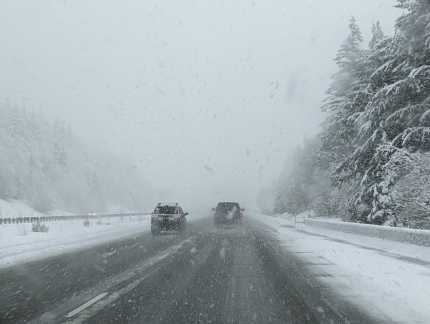 |
Snow
Position: 47°26.31’N, -121°39.05’W
Heavy snow falling on I-90 at altitude 1,250 ft (381 m). Snowpack usually peaks around Snoqualmie Pass by April 1, so mid-April isn’t unusually late for snowfall. But it is a lot more fresh snow than has fallen for the past few weeks.
|
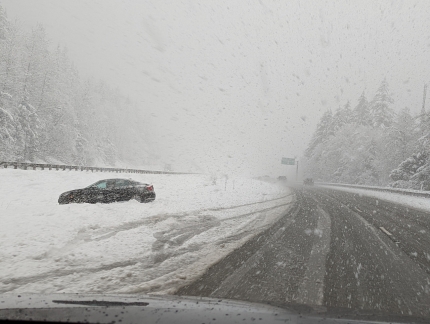 |
Slid Off
Position: 47°25.53’N, -121°36.23’W
By altitude 1,384 ft (422 m), the snow was starting to build up and several cars had slid off the road.
|
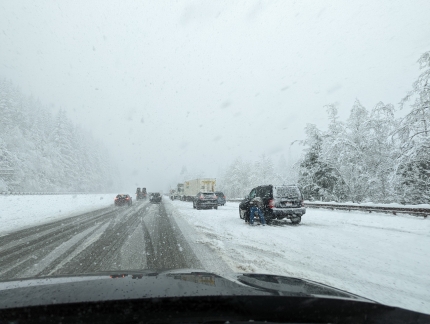 |
Chaining Up
Position: 47°24.74’N, -121°34.97’W
Multiple vehicles, including several highway trucks, stopped along the side of the road to install chains. In the current conditions, traction tires are advised and oversized vehicles aren’t allowed, but chains aren’t required.
|
 |
Police
Position: 47°24.02’N, -121°33.28’W
Several police cars at another accident near Snoqualmie Pass. With traction tires and AWD, we weren’t having any trouble in the snow, and neither were most of the other vehicles travelling with us.
|
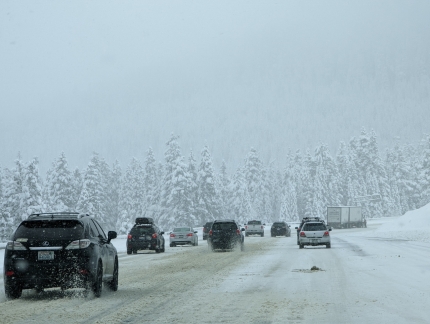 |
Truck Stopped
Position: 47°25.56’N, -121°25.74’W
Near the Snoqualmie Pass ski area, the truck visible in the distance has stopped right in the middle of I-90 while the driver installs chains.
|
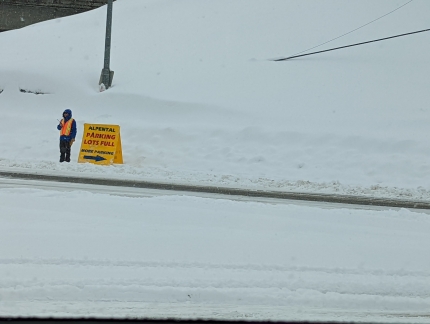 |
Alpental Parking Full
Position: 47°25.63’N, -121°25.05’W
We were surprised to see the Alpental parking lots were already full given we were arriving at about the same time as yesterday. Likely not all lots have been plowed and they’re operating at reduced capacity.
|
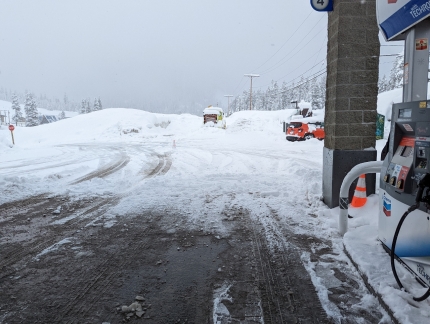 |
Snow From Roof
Position: 47°25.38’N, -121°24.75’W
Just after we pulled into this gas station, a huge pile of snow slid off the roof and landed right behind us, covering our tracks leading in.
|
 |
Deep Snow
Position: 47°23.84’N, -121°23.69’W
Deep snow at the Gold Creek Sno Park. This is the same area where we snowshoed a few weeks ago, but this time we’re heading on a different hike to towards the Kendall Peak Lakes. The snowshoe season for this hike typically extends to early March, but it’s still viable with the late-season snow.
|
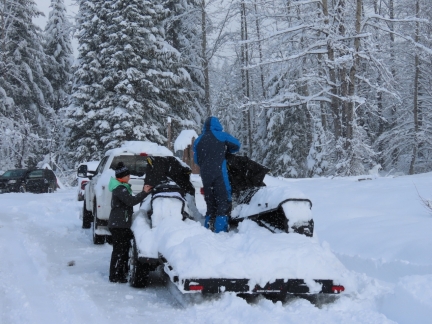 |
Snowmobiles
Position: 47°23.84’N, -121°23.69’W
Snowmobilers unloading their vehicles at the Gold Creek Sno Park.
|
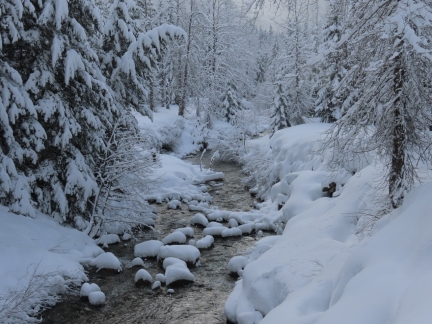 |
Coal Creek
Position: 47°23.90’N, -121°23.66’W
Fluffy, fresh snow along Coal Creek at the Gold Creek Sno Park. A Coal Creek also is in Bellevue, on Seattle’s Eastside, but that one originates in the more western Cougar Mountain area.
|
 |
NF 2235
Position: 47°23.92’N, -121°23.64’W
A beautiful winter scene on the trail following National Forest Road 2235 to the Kendall Peak Lakes. We’re among the first ones here with only two sets of snowshoe prints ahead of us.
|
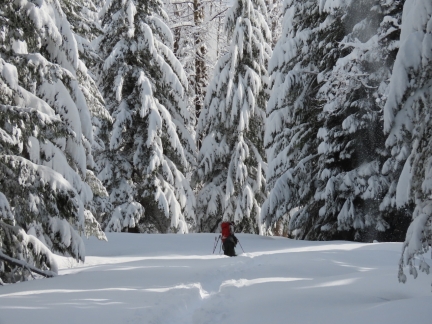 |
Another Snowshoer
Position: 47°23.93’N, -121°23.62’W
We’re catching up to the other two snowshoers who came ahead of us.
|
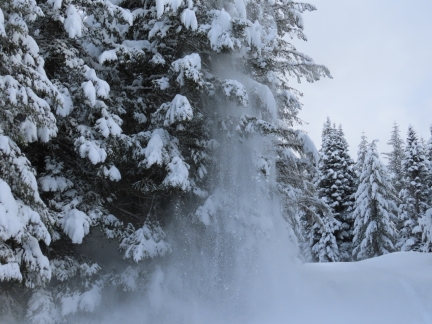 |
Branches
Position: 47°23.95’N, -121°23.62’W
The weight of the fresh snow causes frequent dumps from the tree branches.
|
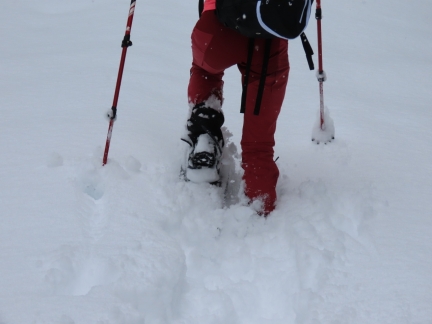 |
Sinking In
Position: 47°24.18’N, -121°23.58’W
We passed the other two snowshoers, stopped on the trail, and continued on through unbroken snow. Even wearing snowshoes, we sank a long way into the light powder.
|
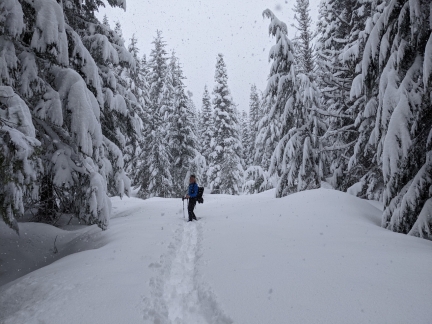 |
Blazing Trail
Position: 47°24.22’N, -121°23.63’W
Blazing a trail through the fresh snow, with more snow falling. Cutting a fresh trail in the snow is considerably more tiring than following an existing path to we frequently swapped places whenever the leader got tired.
|
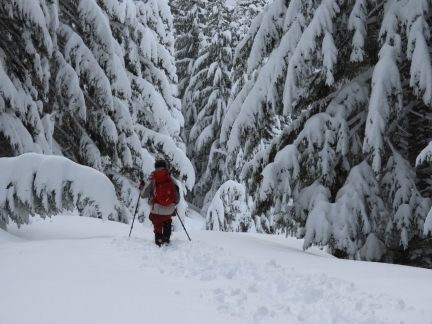 |
Passing
Position: 47°24.68’N, -121°23.77’W
One of the two snowshoers we’d passed earlier caught up to us, thanking us for breaking the path. We’d enjoyed walking through the fresh snow, but were happy to take a break and follow his trail for a bit.
|
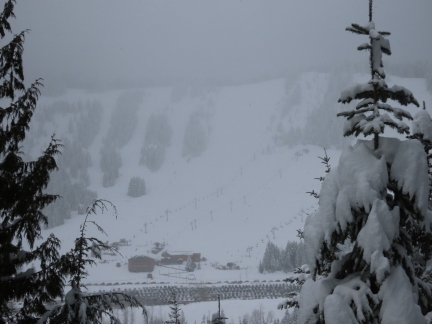 |
Ski Area
Position: 47°24.76’N, -121°23.69’W
View to the Snoqualmie Pass ski area from the trail to Kendall Peak Lakes. The parking lot, at the bottom of the picture, looks packed.
|
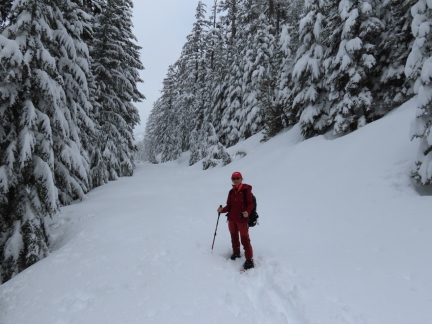 |
Stopping Point
Position: 47°24.79’N, -121°23.70’W
The Kendall Peak Lakes were another couple of hours hike, farther than we felt like going, so we turned around partway up.
|
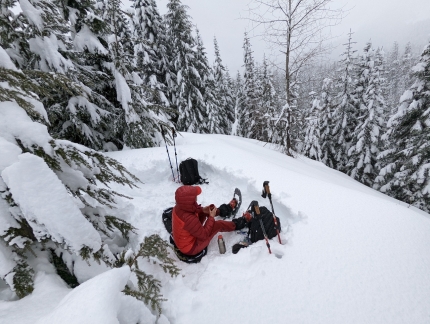 |
Snack
Position: 47°25.14’N, -121°24.01’W
We followed the National Forest 020 spur road to an open area with a view and stopped there for a snack and a hot drink after making a small clearing to sit in. We didn’t get much of a view with snow still falling, but we enjoyed our little spot.
|
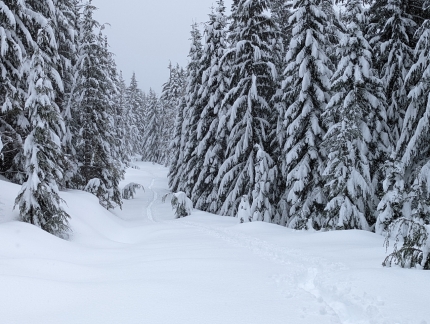 |
NF 020
Position: 47°24.98’N, -121°23.99’W
Looking east down our path along National Forest Road 020 back towards the main trail.
|
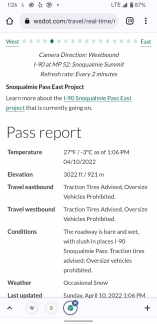 |
Road Conditions
Position: 47°25.49’N, -121°24.67’W
A lot more snow had fallen since we’d arrived for the hike, and road conditions looked a little dicey. We were expecting that chains might be required at this point, but the guidance hadn’t changed from this morning’s “traction tires advised”. This is the lowest of the Washington mountain pass traction requirements. The next level up is “traction tires required”, then “chains required” (except for 4WD/AWD vehicles), and finally “chains required for all vehicles”.
Our Honda Passport has traction tires and AWD, so we only are required to put on chains for that final level, but must be carrying them in the third level. Given the conditions now, the roads must be pretty bad when chains are required for all vehicles. |
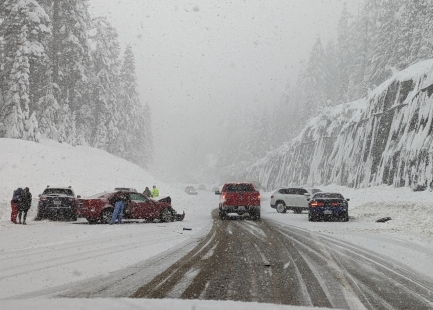 |
Multi-Car Accident
Position: 47°25.76’N, -121°25.42’W
A multi-car accident a short distance west of the Snoqualmie Pass ski area. Several of the vehicles looked badly damaged, but no-one was obviously hurt. The accident had just happened and we felt lucky to have missed that one.
|
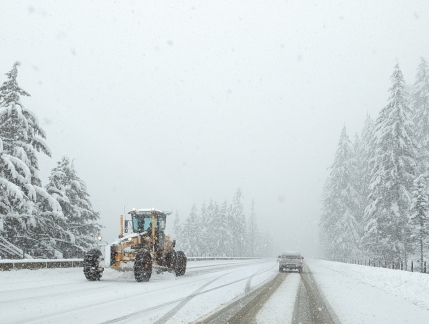 |
Snowplow
Position: 47°25.52’N, -121°26.04’W
Snowplow heading eastbound in the westbound I-90 lanes. With the amount of snow still falling, conditions won’t improve up here anytime soon. But they gradually improved as we descended, and we were back in rain for our traditional post-snowshoe lunch at the North Bend Bar and Grill.
|
 |
Click the travel log icon on the left to see these locations on a map. And a map of our most recent log entries always is available at mvdirona.com/maps. |
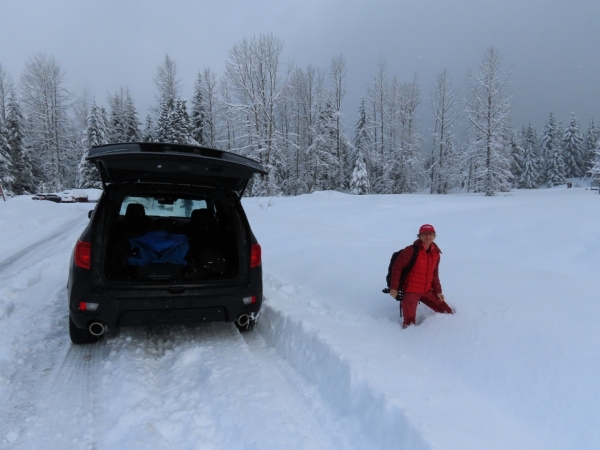
I guess the Honda Passport is not electric or even hybrid. Why that choice ?
I ‘ve read WA state has the third-most electric vehicle registrations relative to miles traveled (source:LendingTree) and about 10% EV/totalV.
Personally I haven’t bounght EV for a simple pragmatic reason: range anxiety. Plus, living in a flat, we don’t have a garage to plug-in overnight. (Italian % of flats/houses is 70/30).
I’m curious of your opinion on that choice.
Raffaele, Italy
That’s a good question. Living in an apartment building without an EV connection at the parking spot makes efficiently operating a full electric vehicle more complex. If we did have an electrical connection, I think we probably would likely have gone with an EV. We certainly could have gone with a hybrid and, if there was a car with similar characteristics, we would definitely have gone hybrid. What’s blocking us going with a hybrid is availability of vehicles with similar characteristics. Most hybrid SUVs are either smaller than the Passport or don’t have the performance and usually both. On size, since we camp in the car, space is really critical for us. On performance, we like a vehicle that can comfortably pass at 70 MPH which is an easy goal for EVs or hybrids to achieve but most manufacturers don’t choose to match their ICE vehicle performance in their hybrid or SUV lineup.
In summary the key issue for us was lack of availability of a hybrid SUV of similar size and performance to the Honda Passport. And, on the pure EV side, lack of a way to charge the vehicle in our apartment building. Hopefully we’ll see progress both on vehicle performance and in legislation requiring downtown residential buildings to electrify their parking.